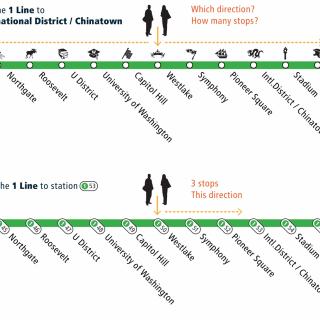Beginning Aug. 30, three-digit station codes will replace the current Link station pictograms. We aim to streamline navigating the Link network through an easy to recall system. The codes represent a significant leap in making our transit network easy to understand and use for those who need them. We are excited about this upgrade and believe it will enhance your experience with Sound Transit.
How the new Station Codes work
Each Link station will have a three-digit station code. The first digit of the code indicates the Link light rail line. Stations on the 1 Line will start with a "1", while those on the 2 Line will begin with a "2". Future 3 Line and 4 Line stations will start with a "3" and "4," respectively.
The following two digits are the stop code for each station. Starting with "50" at Westlake, our centermost station, each station will have a new two-digit stop code paired with the lines that service it. Thus, Westlake is designated as 1-50. Once we connect the 2 Line, it will also be station 2-50.
The codes reflect station locations relative to Westlake Station. The numbers will increase for stations south of Westlake and decrease for stations going north. For example, the International District/Chinatown station to the south will be Station 1-53. In contrast, U District Station to the north will be Station 1-47. When the 2 Line opens across I-90, the numbers will increase south and east and decrease north and west.
We reserved numbers for potential infill stations, for quick adaption as we grow. Current Link system maps on our trains show a "Station Coming Soon" for the future NE 130th St Station (Station 1-44), expected to open in 2026.
How to navigate with Station Codes
Suppose you're traveling from Westlake Station to International District/Chinatown Station. You can quickly identify your origin and destination using the Station Codes—Westlake is 1-50, and International District/Chinatown is 1-53. You know your trip will be southbound for three stops because the station code number increases.
Why do the station numbers decrease going north and increase going south? Shouldn’t it be the other way around?
You might wonder, “If interstate highway exits decrease in number traveling southbound, why do Link station codes increase when traveling south?” Good question! During our cultural review, we discovered that in some communities and the languages they speak hold certain beliefs or superstitions about specific numbers.
For example, many English-speaking Americans consider the number “13” unlucky. In some East Asian cultures, the number “4” is considered unfortunate. For some Afghani communities, the number “39” has negative associations.
Hence, we sought to avoid any potential negative associations with the neighborhoods and communities we serve. Designating a station in a neighborhood with high Chinese and East Asian populations with codes containing 4 could have been offensive.
How did Sound Transit decide on three-digit station codes?
Washington state law requires alternate Link station identifiers not based on the Roman alphabet to assist limited English proficiency (LEP) passengers, visitors, and riders with disabilities. Initially, Link stations featured small graphical symbols representing nearby landmarks or neighborhood identifiers: a Pride flag represented Capitol Hill Station, an anvil for SODO Station, etc. These pictograms served us well but became difficult to adapt as we prepared to expand Link in the coming years.
Likewise, station numbering is international best practice. During our peer review, we studied transit systems in Tokyo, Seoul, and Dubai to inform our design. Arabic numerals, unlike pictograms, are more globally recognized, making them more accessible to residents and visitors.
Developing our new station code system was a thorough and thoughtful process. In 2022, we extensively tested with LEP groups in multiple languages to ensure the new system meets their needs. After extensive evaluation, we gained approval from the Ridership Experience and Operations Committee. In 2024, we stress-tested and culturally reviewed this alternative identification system.
Additionally, we tested our pictograms against other numbering systems using six focus groups in five different languages to ensure our new system is effective and user-friendly. 58% of survey participants said three-digit station codes would be helpful, and 58% said the pictograms were not helpful. Less than 20% of respondents said they used the station pictograms for navigation.
This system allows for easy, consistent additions for future Link extensions. These codes indicate the number of stops between stations so some riders can plan their journeys easier. Station Codes focus on wayfinding over local branding, prioritizing easy navigation of our transit network.

